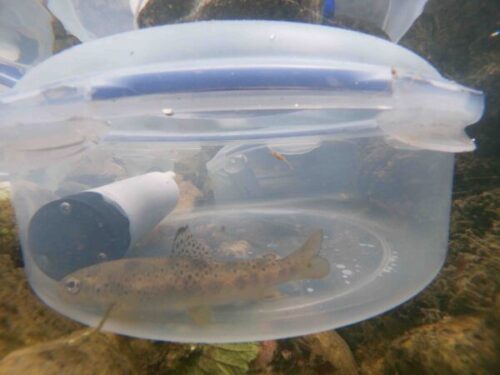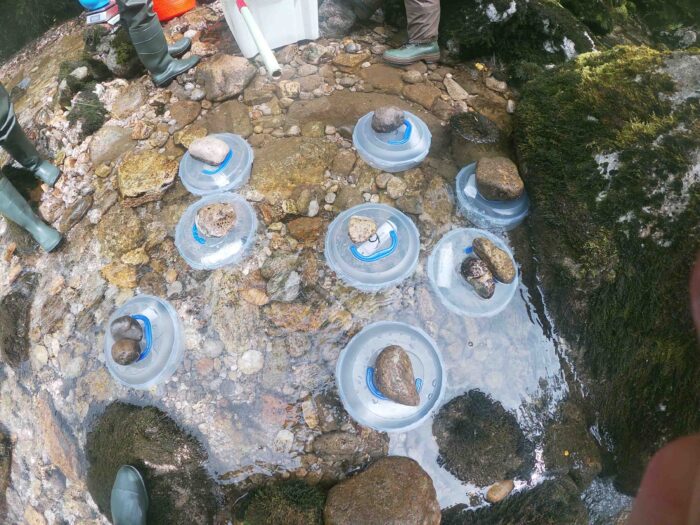The miniDOT® Logger is a completely submersible instrument that logs dissolved oxygen and temperature measurements. Data is recorded on the internal SD card and operational functions, like setting time and sample intervals, can be accomplished via USB cable. The oxygen sensor is an optode that measures dissolved oxygen concentration in water through a fluorescence method. The miniDOT® can withstand temperatures ranging from 0 – 35°C.

Zebra Mussels: Aquatic Invaders
April 17, 2023
The Marvelous Missing miniDOT®
June 13, 2023Continuous Metabolic Monitoring with the miniDOT® Logger
Project Details
- PRODUCT(S): miniDOT® Logger
- APPLICATION: Surface Water
- PARAMETER: Dissolved Oxygen, Temperature
- LOCATION: England, Iceland, Spain
- ORGANIZATION: University of Essex
- RECOGNITION: Eoin O’Gorman

Warming Waters and Metabolic Rates
As climate change continues to warm our world and its waters, scientists and researchers across the globe have spent years attempting to understand and predict the ramifications such warming will have on Earth’s ecosystems. Predictions can range from mild effects to the catastrophic, but one team of researchers are finding that a seemingly innocuous choice could be skewing findings. Dr. Eoin O’Gorman and his team at the University of Essex have been studying the ecological impacts of climate change with a particular interest in scaling up the effects of warming on individual physiology to predict the consequences for entire ecosystems. Their latest research has taken them across Europe investigating how temperature alters the metabolic rates of salmonid fish like Brown Trout and Atlantic Salmon.

Metabolic rate refers to an organism’s energy expenditure. While many factors like activity levels or stress can impact metabolic rate, it scales consistently with body size and environmental temperature. Warm-blooded endotherms may metabolize energy to maintain their body-temperature, but cold-blooded ectotherms such as fish are dependent on their environmental temperature to mediate their metabolic rate. This dependance is what makes climate change potentially calamitous for fish populations, but Dr. O’Gorman and his colleagues suspect salmonids possess a greater adaptive capacity than previous researchers have suggested. With the help of PME’s miniDOT© Logger, O’Gorman’s team were able to monitor the metabolic response of fish within their own environments across naturally occurring gradients of water temperatures.
Salmonid Studies
While Dr. O’Gorman and his team are not the first to investigate the relationships between metabolic rate and temperature, their approach in doing so sets them apart. Similar experiments might subject fish to acute temperature changes or take place in laboratory environments, both of which would inflict greater stress levels upon the fish. Heightened stress can artificially inflate metabolic rates, and the short duration of experiments could deny fish adequate time to become accustomed to spontaneously higher temperatures. Together these factors have contributed to findings indicating a grim future for salmonid populations. However, Dr. O’Gorman emphasizes climate change is a gradual process meaning fish are unlikely to experience acute changes in their environments and may have the ability to adapt when given sufficient time. This reinforced O’Gorman’s choice of in-field experimentation and led him and his team to test metabolic rates across many different rivers and streams of varying natural temperatures.
O’Gorman and his colleagues took great care to conduct their experiments in minimally stressful ways while in the field. Studies were conducted for less than three hours at a time, and the miniDOT’s continuous automated monitoring capacity removed the need for manual probing. This ensured fewer disturbances to the fish and maintained the integrity of a sealed testing environment.
Ultimately, O’Gorman and his team concluded that Brown Trout and Atlantic Salmon may have a greater adaptive capacity than other predictive models have suggested. When reducing stressors like acute differences in temperature or experimental environment, O’Gorman and his colleagues found no evidence of temperature dependance on their test subjects’ metabolic rates. 
However, when O’Gorman and his team recreated acute temperature shifts by moving fish to warmer streams nearby, they did observe sharp increases in metabolic rates characteristic of other acute-exposure studies. Dr. O’Gorman and his team intend to build on this research by investigating genetic changes in fish because of temperature change. By determining whether the fish are acclimating versus adapting in the wake of these exposures, researchers like O’Gorman can better determine the salmonids’ chances of coping with life in a warmer world.

